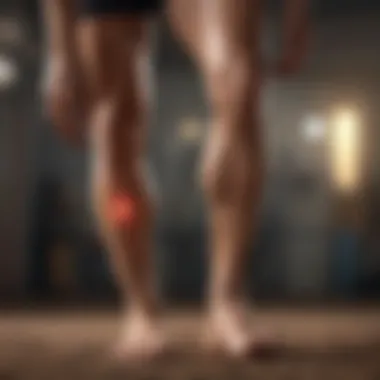Effective Strategies to Relieve Leg Cramps


Intro
Leg cramps, often experienced as sudden and involuntary muscle contractions, are a common yet troublesome issue that can hinder daily activities. They often arise at inconvenient moments, causing discomfort that can last from a few seconds to several minutes. Understanding these cramps’ underlying causes is essential to effectively manage and alleviate their occurrence. By examining various strategies to relieve leg cramps, individuals can reclaim a sense of comfort and improve overall quality of life.
This article aims to provide valuable insights into effective relief methods for leg cramps. It explores the physiological basis of these muscle spasms and offers practical steps to prevent and minimize their impact. By synthesizing knowledge on this topic, the article serves as a resource for those seeking to enhance their physical activities and maintain an active lifestyle.
Key Benefits
Physical Health Benefits
Addressing leg cramps not only provides immediate relief but also contributes to overall physical well-being. Reducing the frequency and severity of cramps can improve one’s ability to engage in physical activity, fostering endurance and strength over time. Regular exercise coupled with effective preventive measures can mitigate the risk of cramps.
Maintaining proper hydration and electrolyte balance is crucial since dehydration can lead to muscle contraction issues. Ensuring sufficient intake of potassium, calcium, and magnesium can also play a pivotal role. Adding foods rich in these minerals, such as bananas, yogurt, and leafy greens, can support muscle function.
Mental Well-being Enhancements
The discomfort resulting from leg cramps can lead to frustration, anxiety, and stress. By finding effective relief strategies, individuals can experience an improved mental state. The knowledge that one has control over managing and preventing leg cramps can foster a sense of empowerment. This mindset shift can enhance engagement in physical activities, training, or even daily chores, allowing one to focus on tasks without the fear of disruptive cramps.
"Knowledge of effective strategies empowers individuals, leading to increased confidence in managing their health."
Practical Tips
Effective Meal Planning
To combat the nutrient deficiencies that contribute to leg cramps, planning meals that include essential vitamins and minerals is vital. Incorporating a variety of foods will ensure balanced nutrient intake. Consider the following:
- Fruits: Bananas, oranges, and avocados are high in potassium.
- Dairy Products: Yogurt and cheese can provide calcium for muscle function.
- Leafy Greens: Spinach and kale offer magnesium, a crucial element in muscle relaxation.
Furthermore, staying hydrated by drinking adequate water throughout the day complements proper nutrition.
Quick and Efficient Workouts
Incorporating short, targeted exercises into daily routines can strengthen the muscles and reduce the likelihood of cramps. Some beneficial activities include:
- Stretching: Regularly stretch muscles in the legs, focusing on quadriceps, hamstrings, and calves.
- Strength Training: Use bodyweight or resistance bands to build strength.
- Low-Impact Cardio: Activities like cycling or swimming can enhance circulation and reduce muscle tightness without putting excessive strain on the body.
By implementing these practices, individuals can effectively manage leg cramps and promote a healthier lifestyle.
Understanding Leg Cramps
Leg cramps are an involuntary contraction of muscles in the legs that can cause significant discomfort. To effectively manage and prevent these cramps, it is crucial to understand their underlying mechanisms. By learning about the nature, causes, and risk factors associated with leg cramps, individuals can tailor their approach for relief and prevention.
An important aspect of recognizing leg cramps is the different types that exist. They can occur during rest or physical activity and often involve varying muscle groups. Understanding these types will help in identifying the appropriate strategies to address them.
Moreover, awareness of causes like dehydration, nutrient deficiencies, muscle fatigue, and poor circulation adds layers to one’s comprehension. Each of these factors plays a vital role in triggering cramps. Furthermore, identifying risk factors such as age, gender, physical activity levels, and underlying health conditions enhances the ability to approach prevention with strategy.
The exploration of leg cramps encompasses a wide realm of physiological aspects and lifestyle choices. Overall, a deep understanding of leg cramps not only assists individuals in confronting this common issue but ensures they can maintain a more active and fulfilling lifestyle.
Immediate Relief Techniques
When leg cramps occur, immediate relief techniques are crucial for alleviating pain and discomfort. Understanding and applying these methods can provide quick alleviation and help restore normal muscle function. Importantly, these techniques offer various approaches, including stretching, heat application, and massage. Each technique has unique qualities that may be more effective for certain individuals or situations. Hence, exploring these methods can empower individuals with effective strategies to manage their cramps promptly and efficiently.
Stretching Exercises


Stretching exercises are vital for relieving tension in muscle fibers during a cramp. They work by allowing muscles to relax gradually. Their effectiveness lies in targeting specific muscles that typically cramp, making them a popular choice among those experiencing leg cramps.
Calf Stretch
The calf stretch primarily focuses on the gastrocnemius and soleus muscles. These muscles are often involved in leg cramps, especially during physical activities. What makes the calf stretch particularly beneficial is its simplicity and ease of access.
To perform it, a person can stand facing a wall and place one foot behind the other, keeping the back leg straight. Leaning toward the wall will generate a gentle stretch. This stretch can relieve tension in the calf area.
One unique feature is how effective it can be when performed at the first sign of a cramp. However, it may require some caution. Overstretching can worsen discomfort if muscles are already under strain.
Hamstring Stretch
Hamstring stretches target the large muscles at the back of the thigh. These muscles can also contribute to leg cramps, particularly during prolonged sitting or standing. The key characteristic of this stretch is its ability to alleviate tightness in the hamstrings.
To perform a basic hamstring stretch, one can sit on the floor with legs extended and reach toward the toes. It is a beneficial choice as it not only targets the hamstrings but also improves overall flexibility.
While the hamstring stretch is effective, it may not provide enough immediate relief for everyone. Some may find it difficult to perform properly if they have underlying flexibility issues.
Quadriceps Stretch
The quadriceps stretch focuses on the front thigh muscles. It is essential since tight quadriceps can lead to imbalances that cause cramps. The key characteristic of this stretch is the engagement of the hip flexors and quadriceps altogether.
To perform a quadriceps stretch, individuals can stand and pull one foot towards the glutes, holding the ankle. This stretch is beneficial for maintaining muscle balance and preventing tension.
However, the disadvantage is that if someone has knee issues, this stretch could exacerbate discomfort or even lead to injury.
Heat Application
Heat application is a widely recognized method for enhancing blood flow and relaxing muscle fibers. This approach can be particularly soothing during a cramp and is easy to integrate into one’s routine. Various heat methods can help relieve cramps quickly.
Warm Compress
Using a warm compress is a straightforward method. A cloth soaked in warm water can be applied directly to the cramping area. One beneficial aspect of a warm compress is its ability to offer immediate relief and promote relaxation of the tight muscles.
Additionally, a warm compress is easy to use and does not require fancy equipment. However, a potential downside is managing the temperature, as too much heat can lead to burns or discomfort.
Heating Pads
Heating pads provide consistent warmth to a specific area. They are often more comfortable for prolonged use compared to compresses. The key characteristic of heating pads is their ability to maintain a steady temperature. This characteristic can be especially helpful for those dealing with recurring cramps.
One advantage is that they can be used while resting or sleeping. However, awareness of escessive heat is important to avoid burns on sensitive skin.
Hot Baths
Taking a hot bath can offer an all-encompassing relaxation experience. The immersion in warm water helps remove tension from the entire lower body, not just localized areas. This is particularly beneficial as it also allows dips in other areas of the body subjected to tension.
Despite their advantages, hot baths require substantial time and effort compared to other methods like heating pads or compresses. Additionally, they may not be practical for immediate situations, such as during a sudden cramp.
Massage Techniques
Massage techniques can be highly effective in releasing muscle tightness and reducing discomfort. By applying pressure to the affected area, individuals can promote blood flow and facilitate muscle relaxation.
Various techniques exist, with some focusing on deeper muscle groups while others offer surface-level relief. Whichever method is chosen, it is crucial to approach gently to avoid exacerbating the pain during a cramp.
In summary, using immediate relief techniques such as stretching exercises, heat application, and massage can provide various options for quick relief during episodes of leg cramps. Each has its distinct attributes, and the choice may vary based on personal preference and specific circumstances.


Preventive Measures
Preventive measures are crucial in managing leg cramps. Establishing good habits can help reduce the frequency and intensity of these discomforting episodes. Prevention focuses on addressing the underlying causes, promoting overall well-being, and ensuring the body functions optimally. In this section, we will highlight effective strategies that can complement other relief methods outlined earlier.
Hydration Strategies
Staying hydrated is essential to prevent leg cramps. Dehydration can lead to muscle cramps as it disrupts the proper function of electrolytes, which are crucial for muscle contractions and overall muscle performance. It is not just about drinking water; understanding one's daily fluid requirements and ensuring adequate intake of fluids is key. The color of urine can be a simple indicator of hydration status. Pale-yellow urine often suggests proper hydration, while darker urine signals a need for more fluids.
Proper Nutrition
Nutrition plays a significant role in preventing leg cramps. Certain nutrients are vital in muscle health and preventing cramps.
Electrolyte Balance
Electrolytes are minerals that carry an electric charge and help transmit signals in the body. This balance is critical for muscle function. Key electrolytes include sodium, potassium, calcium, and magnesium. A diet lacking these can lead to imbalances, resulting in cramps. Foods high in potassium like bananas, and magnesium-rich foods such as nuts and seeds contribute significantly.
Also, maintaining proper electrolyte levels can improve muscle recovery post-exercise. However, excessive intake of electrolyte supplements can lead to additional complications, hence moderation is necessary.
Vitamin and Calcium
Vitamin D and calcium work hand-in-hand for muscle function and health. Vitamin D helps the body absorb calcium effectively. Insufficient calcium can lead to muscle stiffness and cramps during activities. Foods rich in calcium include dairy products, leafy greens, and fortified foods. Vitamin D comes from sunlight exposure and fortified meals. The unique aspect of this combination is their synergistic effect on muscle contraction and relaxation.
However, relying heavily on supplements without balanced dietary intake may not yield the ideal outcomes and can lead to over-supplementation issues.
Exercise and Fitness Regimens
Adopting a regular exercise routine can significantly aid in preventing leg cramps. A balanced fitness regimen includes stretching, strength training, and gradual increases in intensity.
Regular Stretching
Incorporating regular stretching into daily routines helps keep muscles elongated and flexible. Tight muscles are more prone to cramps. Stretching can be performed at any time, providing major benefits when muscles feel tense. Active stretching, combined with a cooldown phase after activities, reduces the risk of cramps. It allows the muscles to relax and recover.
Strength Training
Strength training builds muscle endurance and strength, which helps in preventing cramps during activities. Strong muscles can withstand prolonged exertion and fatigue better than weaker ones. Key exercises include leg presses, lunges, and calf raises. While beneficial, it is important to use proper form to avoid injuries.
Gradual Intensity Increase
Increasing exercise intensity gradually is essential for preventing cramps. Sudden spikes in exercise intensity may lead to muscle fatigue, which can trigger cramps. Following a structured training plan where intensity increases slowly allows muscles to adapt and grow stronger over time. It involves carefully monitoring one’s body and adjusting workouts accordingly.
Home Remedies and Lifestyle Changes
The significance of home remedies and lifestyle changes in managing leg cramps cannot be understated. These strategies provide individuals with practical and accessible options to mitigate discomfort and reduce the frequency of cramps. Integrating these methods into daily routines enhances overall muscle health and well-being.
Natural Supplements
Magnesium Supplements
Magnesium supplements play a vital role in muscle function and nerve transmission. This mineral helps regulate muscle contractions, and a deficiency can lead to increased cramping. The key aspect of magnesium is its ability to promote muscle relaxation. Therefore, it is often regarded as a beneficial choice for alleviating leg cramps. Taking magnesium can lead to faster recovery times and improved muscle performance.
However, there are considerations when using magnesium supplements. Excessive intake can cause gastrointestinal issues such as diarrhea. Therefore, moderation is essential. The unique feature of magnesium supplements lies in their versatility, available in various forms like magnesium oxide and magnesium citrate, catering to different needs and preferences.
Potassium Sources


Potassium is another crucial element in preventing leg cramps. This mineral is essential for maintaining proper muscle function and hydration. A key characteristic of potassium is its role in electrolyte balance. It helps transmit nerve impulses critical for muscle contractions. Potassium sources, such as bananas and leafy greens, are beneficial choices for individuals looking to manage leg cramps naturally.
Unique to potassium is its ease of incorporation into the diet. While many people can obtain sufficient potassium through a balanced diet, some may need to consider potassium-rich supplements, particularly if dietary intake is inadequate. However, too much potassium can lead to adverse effects, especially for those with certain health conditions, so consulting a healthcare provider is recommended.
Adequate Footwear
Another strategic approach involves adequate footwear. Wearing supportive shoes can prevent muscle strain and minimize cramps. Footwear that provides proper arch support and cushioning can alleviate pressure points in the legs. It’s crucial to choose shoes that fit well, as poorly fitted shoes can lead to discomfort and contribute to increased cramping episodes.
Additionally, swapping closed-toe shoes for open sandals or slip-ons can offer more comfort when at rest or engaging in light activities. Investing in good quality, supportive shoes is an often overlooked but effective strategy for reducing leg cramps.
Sleep Position Adjustments
Sleep position adjustments can further enhance comfort and reduce night cramps. Certain positions may lead to muscle strain. For instance, sleeping with legs straight may cause tension. Instead, adopting a position where the legs are slightly bent or elevating the legs can alleviate pressure and promote blood circulation.
Using pillows to support the legs during sleep may also help. Adjusting your sleeping posture is a simple yet effective means to mitigate leg cramps during the night. Prioritizing comfort during sleep promotes overall recovery and well-being, facilitating a restful night and a cramp-free morning.
When to Seek Medical Advice
Recognizing when to reach out to medical professionals regarding leg cramps is essential. While occasional cramps are common and often harmless, persistent or severe cramps could indicate underlying health issues. Seeking timely medical advice can lead to proper diagnosis and treatment options, which may improve overall health and quality of life.
Chronic Cramps as a Symptom
Chronic leg cramps can signal that there might be something more serious at play. If cramps occur frequently, exploring their root cause is important. This might involve analyzing lifestyle factors, current medications, or even existing health conditions. In some cases, cramps that are frequent or intense could be a sign of conditions such as peripheral artery disease or diabetes. Observing patterns in when the cramps occur can aid healthcare providers in identifying any potential underlying issues.
It's advisable to take note of the duration and intensity of the cramps, as well as associated symptoms like swelling, redness, or numbness in the legs.
"Chronic cramps should not be ignored, as they may hint at other serious medical conditions that require attention."
Consultation with Health Professionals
Consulting health professionals can provide clarity about the nature of the cramps and what can be done to relieve and prevent them. Engaging with the right specialists can lead to beneficial treatment methods.
Primary Care Providers
Primary care providers are a vital starting point for anyone experiencing persistent leg cramps. Their broad knowledge allows them to assess your health comprehensively. They can perform tests to exclude more serious conditions that might be causing the cramps. This characteristic of offering a holistic approach can prove beneficial as they often have access to family health records, enabling them to recognize patterns that others might miss. However, they may refer you to specialized care depending on the initial assessment and findings.
Nutritionists
Nutritionists focus on diet and food intake, which can directly impact leg cramps. Since deficiencies in vital nutrients may cause or exacerbate leg cramps, consulting a nutritionist can help identify dietary gaps. They can create tailored nutrition plans emphasizing electrolytes, vitamins, and minerals crucial for muscle function. The unique feature of nutritionists is their ability to provide targeted dietary advice, which might be more specialized than general health advice given by other providers. The drawback here is that results from dietary changes may take time to manifest.
Physical Therapists
Physical therapists can provide specialized exercise regimens designed to strengthen muscles and improve flexibility. This can help reduce the frequency and intensity of cramps. Their expertise lies in rehabilitation and prevention, making them a suitable choice for those with muscular issues contributing to leg cramps. Physical therapists often use hands-on techniques along with exercise prescriptions to improve muscle performance. However, their focus is mainly on physical aspects and may need to collaborate with other medical officials for a comprehensive treatment approach.
In summary, understanding when to seek medical advice regarding leg cramps involves recognizing the chronic nature and potential symptoms aligned with this condition. Engaging with primary care providers, nutritionists, and physical therapists creates a robust support system for better managing and potentially alleviating leg cramps.
Ending
Summary of Strategies
To mitigate the discomfort of leg cramps, several strategies have been discussed:
- Immediate Relief Techniques: Stretching exercises like calf and hamstring stretches can provide quick alleviation. Heat application using warm compresses or heating pads further aids in soothing painful muscles.
- Home Remedies: Incorporating natural supplements, especially magnesium and potassium, can help in muscle function and reduce cramps. Adjusting footwear to provide better support and improving sleep positions can also minimize discomfort.
- Preventive Measures: Maintaining proper hydration, ensuring a balanced diet rich in electrolytes, and following a consistent exercise regimen are effective in preventing future occurrences.
These strategies are not exhaustive but serve as a foundation for managing and preventing leg cramps effectively.
Long-term Outlook
The long-term outlook for managing leg cramps involves dedication to lifestyle choices and awareness of one's body signals. Individuals should continually assess their hydration and nutrition to bolster muscle health. Seeking professional advice from primary care providers or nutritionists can further enhance one’s strategy to combat leg cramps.
With ongoing commitment to proper self-care, the frequency and severity of leg cramps can lessen significantly. This proactive approach not only enhances physical well-being but also encourages an active lifestyle free from the interruptions caused by muscle cramps.













